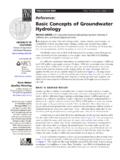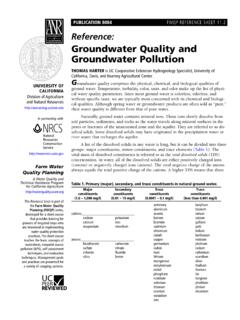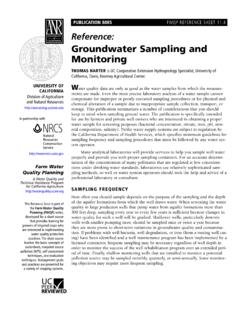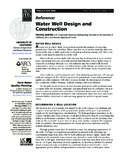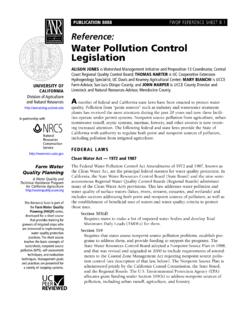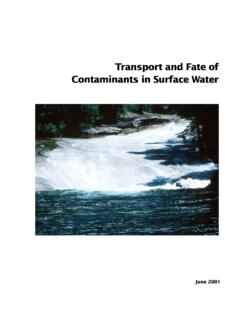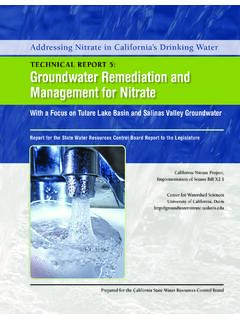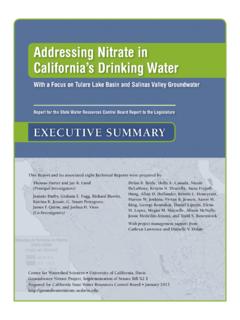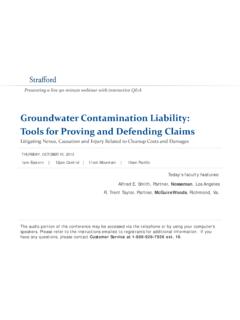Transcription of Groundwater Contaminants and Contaminant Sources
1 Groundwater Contaminants andContaminant SourcesApril 2002 This booklet is part of a series of educational brochures and slide sets that focuses on various aspects ofwater source protection. The series has been prepared jointly by the University of california AgriculturalExtension Service and the california Department of Health further information about this and other documents in the series, contact the project team leader (seebelow) or visit the following : Anthony Saracino and Harrison Phipps, Saracino-Kirby-Snow, Sacramento, : Larry Rollins, Davis, crew: Larry Rollins and Pat SuyamaCover illustration: Treatment system to remove solvents from Groundwater beneath the former McClellan AirForce Base, Sacramento, california . Photo from online image archive maintained by california Department ofWater Resources and University of california ( :80/photos/dwr/).Project Team leader: Thomas Harter, Department of Land, Air, and Water Resources, University of california atDavisFunding Agency: california Department of Health ServicesThis document is the result of tax-supported government projects and, therefore, is not copyrighted.
2 Re-printed material, mainly figures, is used with permission, and Sources are indicated. Statements, findings,conclusions, and recommendations are solely those of the author(s).Reasonable efforts have been made to publish reliable information; however, the author and publishingagencies cannot assume responsibility for the validity of information contained herein, nor for the conse-quences of using such chapter describes some of thecontaminants commonly found ingroundwater and the Sources associatedwith those of the material in this booklet isadapted, with permission, fromCalifornia Groundwater Management, ahandbook produced by the GroundwaterResources Association of california (GRA).Water quality parameters such as pH,dissolved oxygen, and conductivity,applicable to surface water and togroundwater alike, are not discussed are described elsewhere, in thebooklet in this series that covers the topicof surface water place where surface water makes itsway into Groundwater , organic chemicalsand pathogens potentially can enter(Winter et al.)
3 , 1998). Inorganic chemicalsthat occur naturally in soils, sediments,and rocks for example, dissolvedmineral matter can also degrade thequality of though Groundwater may beplentiful in a particular area, if the qualityof the Groundwater has been degradedby the entry of Contaminants , the aquifer may not beusable as a water supply. Figure 1 shows the locationsof more than 4,000 public water wells in Californiathat have been taken out of service in recent yearsbecause of surface water reservoirs used as drinking watersupplies are fenced to keep people from contaminatingthe water. Signs warn, for example, that the reservoir isa municipal drinking water supply and that no humanaccess is permitted. Unfortunately, groundwaterreservoirs typically are not protected this , land is zoned and developed (or farmed) withoutconsidering the underlying Groundwater aquifers andthe necessity of protecting the aquifer s recharge aquifers that serve as municipal water supplies forthousands of people often are left mostly or can enter aquifers by several means,including: infiltration of surface water through soil,sediments, and rock, direct flow from surface water (especially infractured-rock terrain or karst terrain) direct flow through improperly built wells thatbecome conduits for contamination, or cross-contamination below the ground surfacefrom other aquifers via the casings (piping) ofimproperly built source contamination comes from specificlocations, such as underground storage tanks, septicsystems, and landfills.
4 Nonpoint source contaminationarises from an influx of pollutants over a large area,such as can occur from agricultural wastes and urbanstormwater ContaminantsWater percolating through soils picks up naturally-occurring minerals, salts, and organic compounds. Asthe water migrates downward, the concentrations ofdissolved minerals and salts typically increase, a processknown as mineralization. In some cases, the percolatingwater accumulates mineral concentrations high enoughthat the Groundwater no longer can be used as a watersupply, or even for irrigation, without of the more common natural contaminantsinclude hydrogen sulfide, which often originates as aFigure 1: Over 4,000 public drinking-water wells have been shut downsince 1984, as a result of Groundwater contamination. (Adapted from mapthat appeared in newspaper article by Bowman ( 2001).)
5 Original source ofdata: california Department of Health Services.)Public Water Wells Taken Out of Service Since 1984 Well taken out of service2result of decomposition of organic materials, radon, aradioactive gas formed from the natural decay ofuranium found in many rocks, and arsenic. Theelements iron and manganese also occur naturally inmany california groundwaters. In some areas, theconcentrations of these two constituents ingroundwater exceed federal and state drinking Chromium (Chromium VI)Municipalities and other suppliers of drinking waterhave been required since the 1970s to monitor for totalchromium. Total chromium consists of chromium III,an essential human nutrient, and dissolved chromiumVI (hexavalent chromium). Few data exist regardingthe toxicity of dissolved chromium VI; however, it isChromiumChromium is a naturally occurring element that is ubiquitous in the environment.
6 It is found in rocks, soil,plants, animals, and in emissions from volcanoes. The average abundance of naturally occurring chromium isapproximately 20 ppm in granitic igneous rocks, 120 ppm in shales and clays, and 1,800 ppm in ultramaficigneous rocks. Average concentration in the continental crust is 125 is used for making steel and other alloys, furnace bricks, and dyes, for chrome plating, for leathertanning preserving of wood, and as a rust inhibitor in cooling towers. Chromium is released to the environ-ment through manufacturing processes, disposal of chromium wastes, or burning of fossil fuels (Morry, 1999).CharacteristicsUnder normal conditions chromium exists in two stable oxidation states: chromium III (trivalent), and chro-mium VI (hexavalent). Chromium VI exists as the chromate anion, which is more water soluble and mobile thanChromium fate of chromium in soil and Groundwater depends on the form of chromium present, soil and water pH,and the presence of organic matter and certain VI can be generated in the vadose zone and transferred to Groundwater by the natural process ofoxidation of chromium III by native manganese oxides.
7 Chromium III may also be oxidized to chromium VIunder other naturally occurring oxidizing conditions and during chlorination of drinking water supplies. Chro-mium IV may be reduced through natural processes to chromium III (Chung et al, 2000).ToxicologyChromium III is considered a required nutrient and is not toxic. california EPA Office of Environmental HealthHazard Assessment (OEHHA) does not consider chromium III to be carcinogenic when ingested. Chromium VIparticles have been shown to be carcinogenic when inhaled. The damage is thought to be associated withinflammation of the lung tissue due to contact with a chromium VI particle. Inhaling water mist that containssmall concentrations of dissolved chromium VI ( , in a shower) is not thought to pose the same risk to lungtissue as inhalation of particulate chromium VI. The reasoning is that in a shower, the chromium VI is dissolvedand therefore there is no chromium VI particle to cause inflammation and subsequent tissue no persuasive evidence exists, OEHHA assumes chromium VI poses a carcinogenic risk when in-gested based on the cancer risks from inhaled chromium VI, and on the results of a single ingestion study inlaboratory mice conducted by I.
8 Borneff in 1968 (DHS web page). There seems to be widespread agreementthat the Borneff study and its conclusions were seriously flawed. Due to lack of supporting data (they considerthe Borneff study too flawed for use), US EPA does not view chromium VI as a carcinogen when ingested(Macler, 2001). When ingested, chromium VI is rapidly reduced to chromium III by gastric juices in the Contaminant LevelIn 1977, the california Department of Health Services (DHS) set the Maximum Contaminant Level (MCL) fortotal chromium in drinking water at 50 mg/L. Total chromium is comprised of chromium III and chromium is currently no MCL for chromium VI. Effective January 3, 2001, DHS classified chromium VI as an unregu-lated chemical and monitoring is required. Since OEHHA has established a PHG for chromium, DHS will con-sider revising the current Health GoalOEHHA is required to establish Public Health Goals (PHG) for Contaminants with MCLs and Contaminants forwhich DHS intends to adopt MCLs.
9 A PHG is a health protective goal and not a drinking water standard. OEHHAhas set a mg/L PHG for total chromium and a mg/L PHG for chromium VI in drinking water. The PHG forchromium VI was established on the assumption that chromium VI is of the total chromium and onextrapolation of data from the Borneff study to calculate the risk of one excess case of cancer per millionpeople over a 70-year lifetime. Recent information indicates that chromium VI is 50 to 90% of the total chro-mium in many water supplies (Morry, 1999).3known that particulate chromium VI can becarcinogenic when inhaled. A number of drinking watersuppliers in california rely on water Sources that havetotal chromium concentration greater than thereporting detection limit of 10 micrograms per of those suppliers get their water fromgroundwater , hydrologists and geologists assumed thatchromium VI results mainly from industrialcontamination.
10 It was also thought that wherechromium exists naturally (reported as totalchromium), the chromium VI portion is relativelysmall. These ideas are being re-evaluated in light ofnew evidence, and because chromium in water hasbecome a high-profile issue, thanks in part to the highlypopular movie Erin Brockovich. That movie is basedon a 1996 court case in which residents of the Californiatown of Hinkley won $333 million in compensationfrom Pacific Gas & Electric Company after thecompany s tanks leaked chromium VI into in drinking water has become a subject ofdebate. Some factions propose requiring tighterstandards for this known carcinogen. Others, especiallythose with ties to mining and industry, cite the highcosts of removing arsenic from drinking ContaminantsThreats to water quality are divided among agriculture,spills, leaking underground storage tanks and septicsystems, urban runoff, mining, and industrial leads the nation in agriculture, farming andranching, accounting for around $20 billion in revenuesper year.
